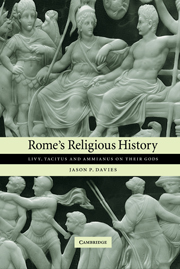5 - Ammianus and a final settlement
Published online by Cambridge University Press: 21 December 2009
Summary
Introduction
Over 250 years passed between the works of Tacitus and Ammianus Marcellinus. How, exactly, we are to think of the religious aspects of the period in which the latter wrote is a complex question that could easily merit a book in its own right. We can point to the survival of many pagan cults and practices for centuries after Constantine. Or, with our long hindsight, we could point to symbolic moments such as the death of Julian, the last pagan emperor, in 363, as the end of a thousand-year-long era. Perhaps the ‘real test’ of the slippery process of Christianisation was the position of the aristocracy, which gives us a slightly later and appropriately more nebulous date. We might see the end of state paganism in the refusal of Gratian to be Pontifex Maximus, probably in 376, or the failure of the so-called ‘pagan revolt’ of 394 and the death of the ‘pro-pagan’ usurper Eugenius in the west. Alternatively, we might adopt a different approach: older models of an all-out contest between paganism and Christianity have been supplanted by models of assimilation, where most aristocrats gradually, and (on the whole) peaceably, became part of the new order. Whatever our criteria, clearly something drastic happened during the fourth and early fifth centuries and any text or other evidence is potentially a part of, and witness to, these processes. Even a single inscription can be a doorway into the politics and religion of the empire on the grandest scale and across generations.
- Type
- Chapter
- Information
- Rome's Religious HistoryLivy, Tacitus and Ammianus on their Gods, pp. 226 - 285Publisher: Cambridge University PressPrint publication year: 2005

